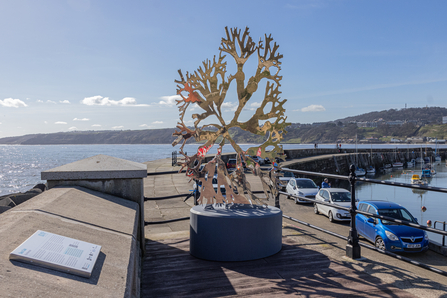
Sheffield-based artist Paul Morrison's Sea Oak sculpture in its environment - Simon Tull
Sea Oak Sculpture - TOS Volunteer Simon Tull

Sheffield-based artist Paul Morrison's Sea Oak sculpture in its environment - Simon Tull
"Art is a harmony parallel with nature"
It seems fitting to me to begin a blog about art and nature with this quotation from post-Impressionist painter Paul Cézanne. His words may be interpreted to suggest Cézanne felt that art can resonate with nature and so connect the artist with the environment.
Something of this ethos underlies YWT's Wild Eye project. Wild Eye aims to create experiences that bring North Yorkshire's coastal communities closer to the natural world, so raising their awareness of the issues surrounding biodiversity and climate change. Public art is at the heart of the project, which is being undertaken in cooperation with Invisible Dust, an art-science organisation that works to promote a wider understanding of environmental issues. Finance has been provided by the UK Government, administered by North Yorkshire Council, the third partner in the project.
Sea Oak
I have always been interested in art as much as I have natural history and so was pleased to be able to attend the unveiling of Sea Oak, the latest addition to the Wild Eye project.
This newly commissioned sculpture by Sheffield-based artist Paul Morrison is a representation of bladderwrack seaweed, Fucus vesiculosus. Bladderwrack, or "Sea Oak" as it is sometimes known, is amongst the most common of over 600 types of seaweed to be found around Britain's coast. The sac-like vesicles that ornament its fronds and act as a buoyancy aid give the species its scientific name. It will be familiar to anyone who has walked along a beach strand line, or who has been rock pooling as a child - or as an adult, come to that...surely this one of the most absorbing of pastimes whatever your age?
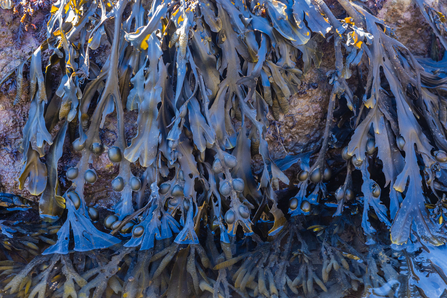
Bladderwrack seaweed (Fucus vesiculosus) or 'Sea Oak' as it is sometimes known, is amongst the most common of over 600 types of seaweed to be found around Britain's coast.
- Simon Tull
Arriving in good time for the opening ceremony, I made my way onto Scarborough's East Pier under beautiful, clear blue skies. The stainless steel sculpture really is very impressive. It has a striking and wonderfully organic form which is in marked contrast to the strictly functional concrete pier it rests on. The surface has been cut and highly polished to mirror the sky and the surrounding cliffs as well as the viewer. The result has a visually pleasing dynamism, with the reflections and colours the sculpture displays in a constant state of change.
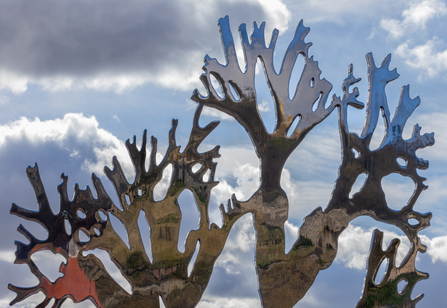
The polished stainless steel means the sculpture can reflect the changes in light of the sea and sky - Simon Tull
Sea Oak is well-placed to get plenty of attention from Scarborough's community of visitors and residents - it's right next to a (typically noisy) funfair. I like to think that people taking a break from being spun, twirled and bounced will investigate the sculpture and think of their connections with nature.
Certainly lots of people took an interest while I was there. It was encouraging to see so much positive engagement from the public. Everyone I spoke to liked it as much as I did, taking to time to take photographs and read the accompanying information board.
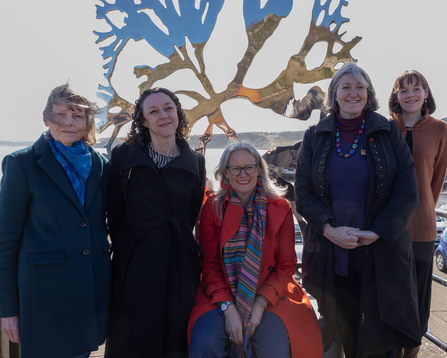
Professor Juliet Brodie (NHM - Natural History Museum), Jeanine Griffin & Alice Sharp (Invisible Dust), Rachel Bice & Caroline Hill (YWT) - Simon Tull
Nature, Art and Community
The speakers participating in the unveiling addressed the three cornerstones underlying the Wild Eye project: Nature, Art and Community. Danielle Daglan from North Yorks Council and Alice Sharp (Invisible Dust) highlighted the social and economic value that art has in bringing people closer to nature. YWT's CEO Rachel Bice spoke of the wide -ranging contributions that seaweeds like bladderwrack make to marine habitats.
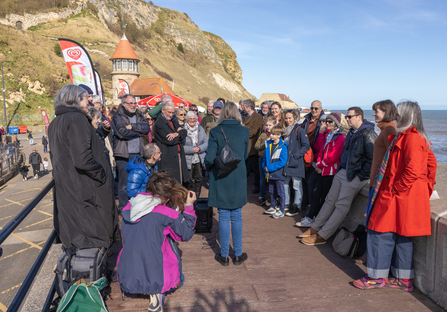
Juliet Brodie (NHM) talking to the audience - Simon Tull
Seaweed Science and Conservation
Good conservation is built on a foundation of good science and the Sea Oak installation has benefited hugely from the involvement of Professor Juliet Brodie of the Natural History Museum, London - a world authority on marine algae.
In her speech, and afterwards at a well attended lecture in Scarborough Library, Juliet spoke of the detrimental impact that climate change is having on seaweeds. She also talked about their economic importance amongst some coastal communities - the very communities that are most at risk from sea level change, storms and rising temperatures. This was something I hadn't appreciated before. On a lighter note, Juliet demonstrated a rather novel way of depicting the vast span of geological time armed only with a piece of a string. I shall definitely 'borrow' this when I give my next geology talk!
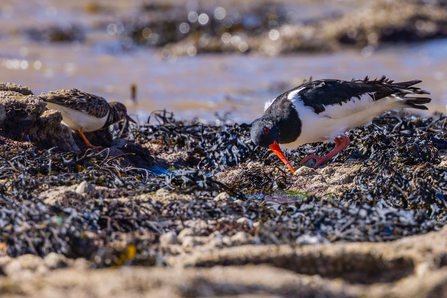
Seaweeds are important in many ways, not least as a food store for wading birds like turnstones and oystercatcher - Simon Tull
Such are Juliet's concerns about their fate that she has been working on a 'Red List' for UK seaweeds. One of the most striking things about this list as it currently stands is that whereas around 10% of species certainly can be considered to be threatened, the distribution of over half of Britain's seaweed species is too poorly known for an assessment of their status to be made. One way of attending to this is through citizen science projects such as the Big Seaweed Search which is being run by the Natural History Museum in London.
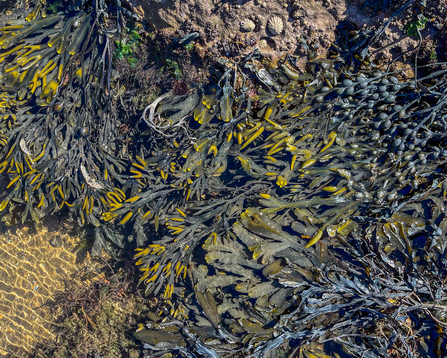
A healthy shoreline community supports many seaweed species - Simon Tull
There are a number of ways in which YWT members and volunteers can contribute to the understanding and health of Yorkshire's coastal habitats. My "Telling Our Story" colleague Howard wrote recently about YWT's participation in "Shoresearch", the Wildlife Trusts' national citizen science survey of the intertidal shore. You can read more here about how it works, and how the data gathered contribute to the designation of our Marine Conservation Zones.
I was listening to BBC radio as I sat down to write this article and heard that in places some hermit crabs are now using plastic waste in preference to marine shells to shelter in, a fairly alarming thought! One very good way to make a contribution to the welfare of our coastal habitats is to take part in one of the regular YWT Waves of Waste volunteer beach cleans. Sara, my other "Telling Our Story" colleague, wrote recently about how rewarding this important activity is here.
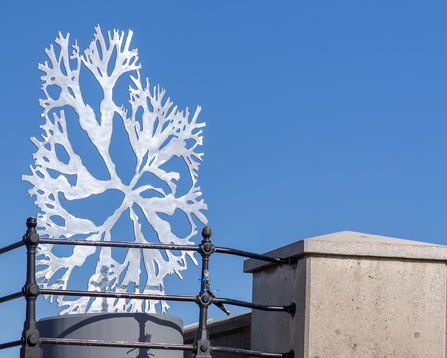
Sea Oak is one of a number of Wild Eye attractions that will grace Scarborough with plans for more attractions to be added in the future as part of the project along the 35km Cinder Track that links Scarborough with Whitby. When complete, all the individual Wild Eye elements will link up in a trail around the town - Simon Tull
Wild Eye Look Ahead
Sea Oak is one of a number of Wild Eye attractions that will grace Scarborough. Visitors to Scarborough Castle can already see 'We are Only Human.' This sculpture is in the form of a "dolos" - a type of sea defence - very appropriate given the extent of marine erosion along Yorkshire's coastline. A covered viewing area where people can watch for dolphins is planned for the coast road north of the harbour, and there are plans for more attractions along the Cinder Track, the 35 km long footpath and cycle way that links Scarborough with Whitby. When complete, all the individual Wild Eye elements will link up in a trail around the town. You can read more about what is planned on the dedicated Wild Eye website which you can find here.
Wild Eye is just that little bit different to the other YWT projects I have seen, and none the worse for it. The more diverse ways that we can find to highlight what is happening to our natural environment the better. I very much look forward to seeing what comes next!